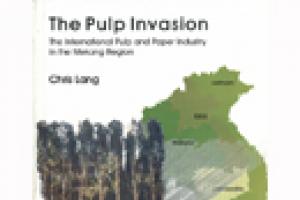This report was produced in 2000-2001 for the World Rainforest Movement, looking at the current state of the pulp and paper industry in the Mekong Region: Thailand, Laos, Cambodia and Vietnam. The research covers the extent of plantations and their social and environmental impacts in the region, the role of the various institutions in supporting the expansion of industrial plantations, and the patterns of local resistance to ecological damage and loss of livelihood.
Vietnam
Publications
9 December 2002
Bulletin articles
12 July 2002
Built at a cost of $1 billion on the Se San River in Vietnam, the Yali Falls dam has caused devastating impacts on downstream communities in Cambodia (see WRM Bulletin 42). At least 32 people have drowned in flash floods caused by sudden releases of water from the dam and villagers have lost livestock, crops and fishing equipment. Poor water quality in the river has led to skin rashes and stomach problems for downstream communities. Fisheries in the Se San River have been dramatically reduced.
Bulletin articles
14 May 2002
Over the last decade the area of fast-growing tree plantations in the Mekong region has expanded dramatically. Villagers throughout the region have seen their forests, fallows and grazing lands replaced with eucalyptus, acacia and pine monocultures. A new World Rainforest Movement report, "The Pulp Invasion: The international pulp and paper industry in the Mekong Region", written by Chris Lang, gives an overview of the industry, profiles the actors involved and documents the resistance to the spread of plantations.
Bulletin articles
20 February 2002
The Tonkin snub-nosed monkey is endemic to northern Vietnam and is one of the world's most endangered mammal species. Before a group was spotted in Na Hang district in 1992, it was considered extinct. Today, 260 of the monkeys are known to be living in northern Vietnam. Half of the population lives in the Na Hang Nature Reserve, which was created in 1994 specifically to protect the snub-nosed monkey.
Bulletin articles
21 January 2002
Last year the Vietnam Paper Corporation (Vinapimex) announced an ambitious plan to expand the pulp and paper industry in Vietnam. With a total cost of more than US$1 billion, the plan involves 15 new pulp and paper production projects. If they were all built, the projects would raise Vinapimex's annual paper production capacity from the current 171,000 tons to 419,000 tons.
The pulp and paper industry in Vietnam presently produces a total of approximately 360,000 tons of paper a year. Vinapimex hopes to increase this figure to more than one million tons by 2010.
Bulletin articles
27 November 2001
Christopher Gibbs of the World Bank office in Hanoi, requested that WRM publish his response to article on Vietnam in WRM Bulletin 51. Mr Gibbs' letter is reproduced in full below, followed by Chris Lang's reply.
November 16, 2001
Dear WRM,
Bulletin articles
27 October 2001
Governments in Southeast Asia have promoted shrimp farming as a means to earning foreign exchange. The beneficiaries of this expansion are private companies such as the Thai agribusiness company, Charoen Pokphand. In Thailand, the World Bank, the Asian Development Bank, Charoen Pokphand and the Thai government worked together to set the scene for expanding the shrimp industry. Companies setting up shrimp farming operations in Thailand were offered generous subsidies including tax breaks, tariff-free imports, tax holidays and export credits.
Bulletin articles
12 April 2001
During the intergovernmental negotiations on climate change (COP-6) at the Hague last November, the Australian government sided with the US, Japan and Canada in refusing to negotiate reductions of its own carbon emissions. Five months later, the Australian government announced five projects aimed at reducing greenhouse gas emissions. Predictably enough, the projects, which are funded through the government's International Greenhouse Partnerships (IGP) Programme, are not aimed at reducing Australia's emissions, but are to be carried out in Peru, Fiji, Malaysia and Vietnam.
Bulletin articles
13 December 2000
The Vietnamese government is currently negotiating with a range of bilateral and multilateral "aid" agencies to raise funds for its five million hectare reforestation programme. So far, little of the estimated US$4.5 billion needed has been formally committed, but in December, the UN Food and Agriculture Organisation (FAO) announced a US$287,000 project "to promote the programme in Vietnam". On 7 December, Nguyen Van Dang, Vietnam's Rural Development Minister and Fernanda Guerrieri, FAO's representative in Vietnam, signed the agreement for the FAO project.
Bulletin articles
17 September 2000
Vietnam has a history of tree plantation programmes dating back to 1956. According to a report by Nguyen Ngoc Lung, Director of Vietnam's Forest Development Department, between 1956 and 1992 an area of over 1 million hectares was planted with trees. However survival rates have been poor and much of the wood produced has been exported as wood chips to Japan or Taiwan.
Bulletin articles
18 June 2000
On February 21st, Vietnamese Prime Minister Phan Van Khai approved the construction of a project to transform the historic Ho Chi Minh Trail into a 1,690 kilometres long National Highway, running from the capital Hanoi to the southern Ho Chi Minh City, former Saigon. According to the authorities, the new route would ease growing congestion on Highway 1, located along the coast, and consolidate national defence along Vietnam's western border with Laos and Cambodia. Cuban engineers belonging to the Cuban-Vietnamese joint venture construction firm VIC will participate in the project.
Bulletin articles
24 July 1999
The spread of exotic species in natural ecosystems worldwide, known as “bioinvasion”, is deserving increasing attention and causing concern. Several plants, including tree species, have been identified as behaving like weeds. For example an African species of acacia (A. nilotica) is being promoted in regions of Africa where it is exotic as well as in India, while in Indonesia and Australia they are trying to eradicate it as a result of its invasive behaviour. At least 19 pine species have invaded various Southern countries’ ecosystems.

